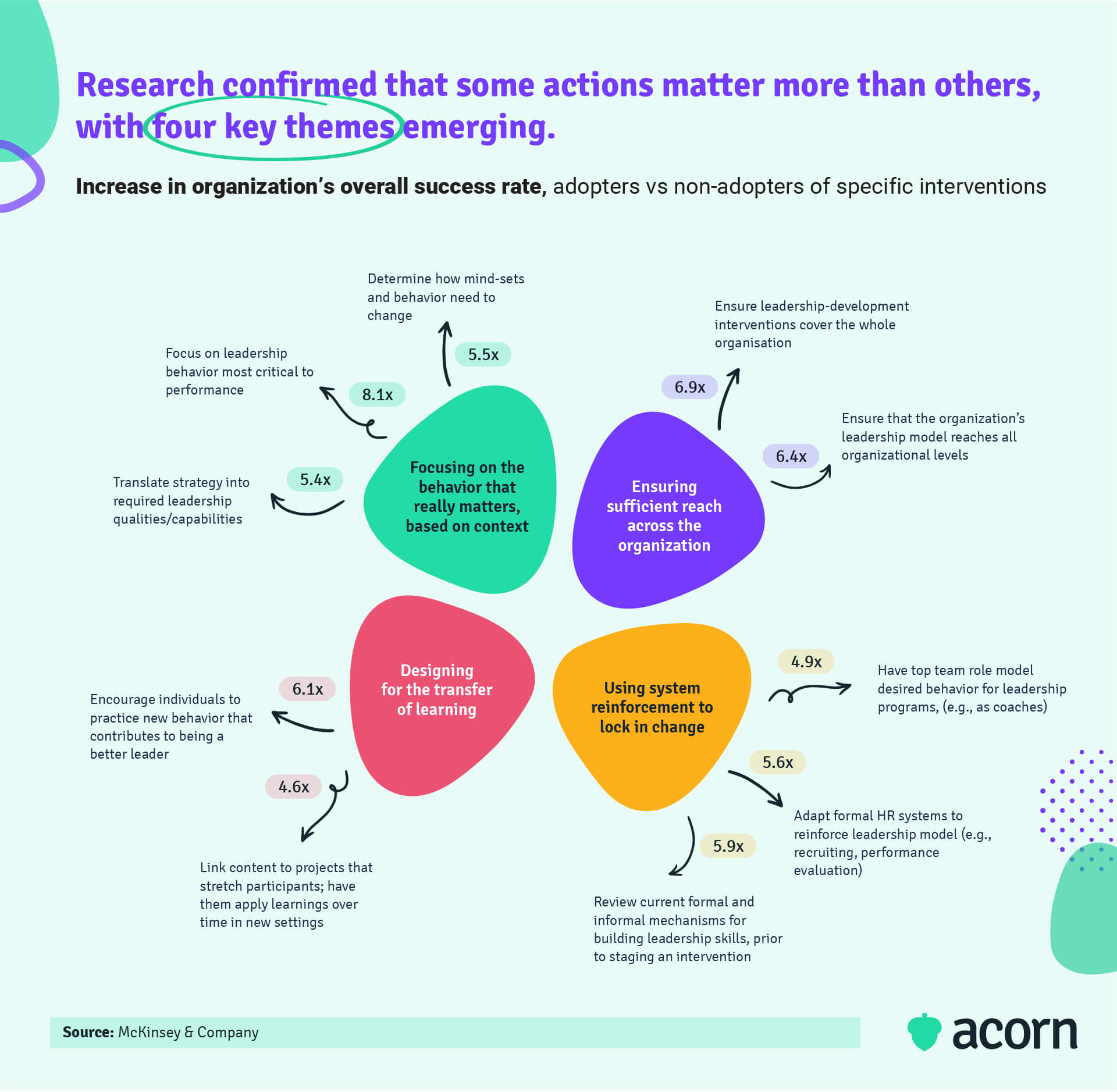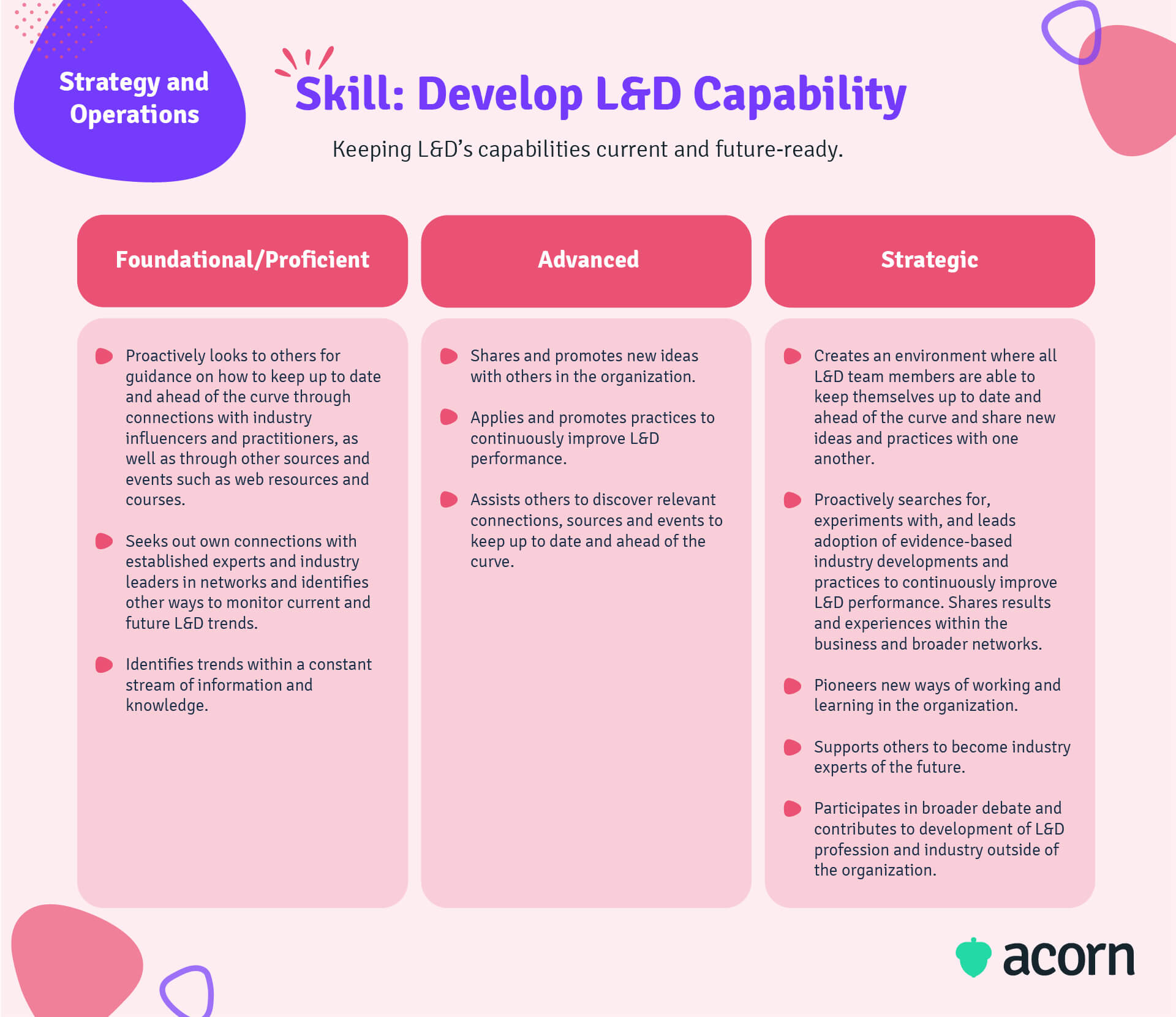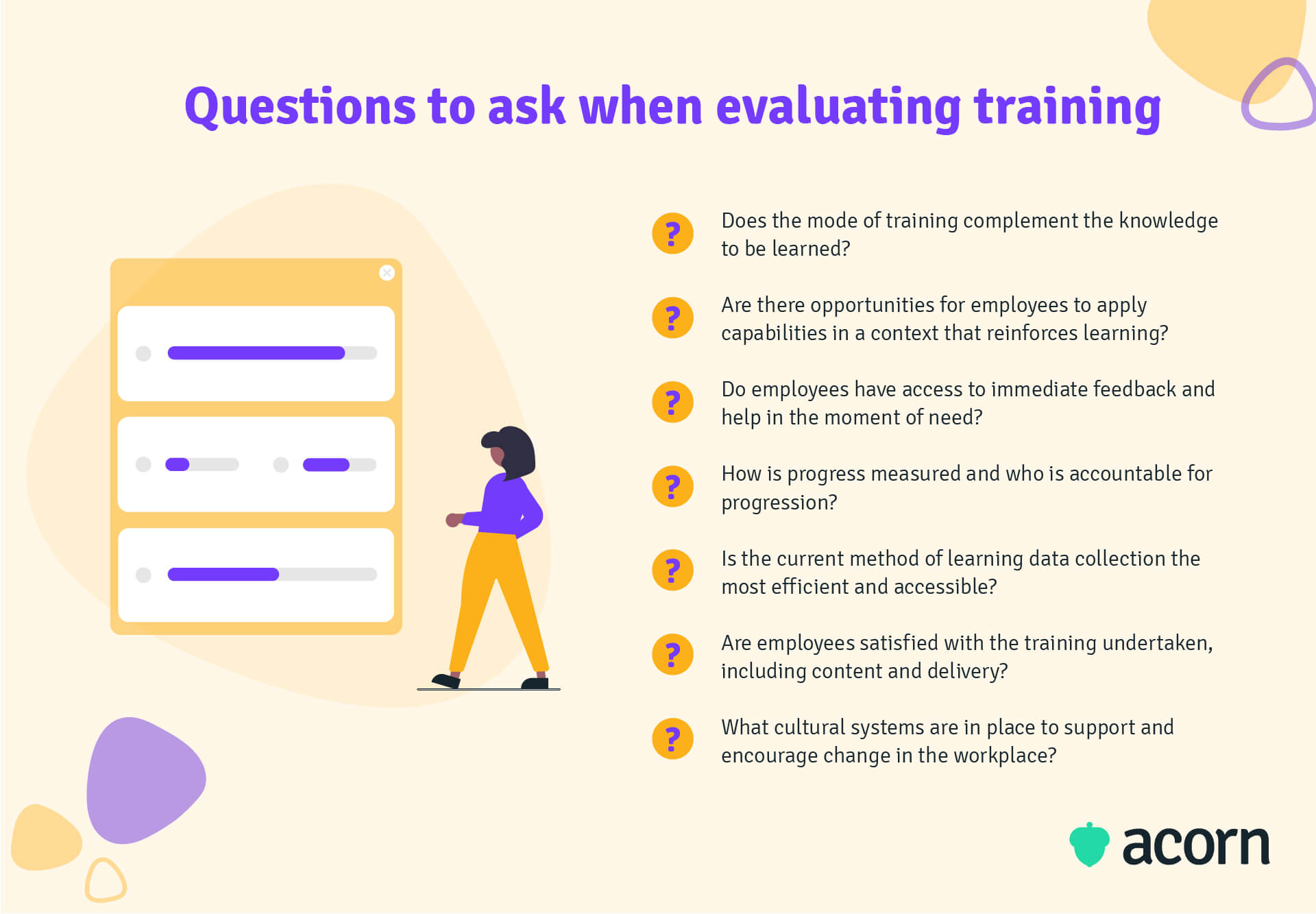Why Leadership Development Planning is Important and How to Create a Leadership Development Plan
Reading Time:

Lead the pack with the latest in strategic L&D every month— straight to your inbox.
SubscribeLeadership development planning plays a valuable role in driving better results for your company, no doubt about it.
Creating a leadership development plan for the strategic and future needs of your organisation is key to business success, not least because leaders turn strategy into action, failures into learning opportunities and problems into solutions.
But not every organisation does leadership development planning well from the start. In this guide, we’ll walk you through the essential components of leadership development as well as the steps you don’t want to miss when creating a leadership development plan.
What is leadership development planning?
Leadership development planning is the process of improving leadership capabilities and preparing future leaders through professional development activities. A leadership development plan details the long-term actions an employee needs to take to advance their career in the context of their organisation.
Why is leadership development planning important?
Leadership development plans are your north star in succession planning and your fallback in a crisis. A development plan:
- Strengthens your current and future leadership bench
- Prioritises critical capabilities by business impact
- Engages employees through personalised career goals
- Helps to identify the strengths and weaknesses of future leaders
- Sets clear performance expectations
- Aligns business strategy with succession planning, solidifying HR as strategic business partners.
Yet just 7% of global CEOs believe their companies are building effective leaders. Many fail in the development stage because:
- Context is overlooked. You can’t appropriate another company’s leadership development plan, because it is tailored for their goals, not yours. That’s not to mention the cultural and strategic nuances of your CEO mandate.
- Companies want leaders to possess a lot of capabilities, rather than excel in a significant few.
- The degree of separation between training and the workplace application is too large. Adults generally retain 10% or less of what is learned in an external classroom.
- Mindsets are underestimated while behavioural change is overestimated. You need mindsets to evolve for employees to develop.
- Impact, performance, and feedback aren’t measured over time, increasing the odds that improvement isn’t taken seriously.
Scary as this may sound, you can turn mistakes into success. Remember that people aren’t just born effective leaders. You need to support and nurture leadership capabilities.
This is just one reason we developed the performance learning management system (PLMS). It’s tied directly to your capability framework, so you can identify, develop, monitor and promote internal leadership talent by way of clear insights into their capabilities. It’s also the only solution that guides learners step-by-step to master the specific capabilities of their (current or soon-to-be) roles, to accelerate organisational performance.
What are the essential components of leadership development planning?
McKinsey found four interventions that are crucial for effective leadership development.

Funnily enough, they’re also the most common mistakes made by businesses that are trying to improve leadership capabilities. So, while you want leadership development that suits your company culture and strategic needs, there are a few core components to follow that make for a successful leadership development plan.
- Continuous identification of talent across the organisation
- Ongoing support and reinforcement for learning transfer
- Milestones and leadership development goals to focus on behaviours that matter
- Organisational accountability to ensure change truly occurs.
Identifying high potential
While you want your entire workforce to exhibit leadership qualities, there will be a few who stand out with budding leadership capabilities. High potential employees (HiPos) are those you want to fast-track on a leadership development plan.
You can use some human qualities to enable data-driven identification of your HiPos. What does this mean? Well, a HiPo is noted for learning quickly and applying new skills faster than their peers. If you’ve got a PLMS, you can use existing learning data to find those knowledge sponges. Progress and completion rates will tell you how fast employees are getting through training content, which gives you a gauge of comprehension. Competency models and capability maps can show you how advanced that knowledge is.
Performance reviews are where you can combine this data with the human side of leadership. HiPos can take constructive criticism, are team players, embody values and wield influence in and outside of their teams. Managers can tell you who’s got a foundation of soft skills necessary for effective leadership.
HiPos can emerge in new roles or circumstances. It may take time for them to reveal themselves, so be sure to make identification a continuous process.
Using leadership teams
Many companies have a core leadership team who help set strategy, prioritise conflicting agendas and make decisions at large, without needing the CEO’s direct input. If you’ve got one, think about incorporating your new leaders into this team to pair them with company veterans who have complementary strengths.
While it benefits the organisation to centralise its diverse strengths and provide training at scale, it also creates a network for burgeoning leaders to:
- Understand other critical areas of leadership (one person can’t know everything, after all)
- Learn how to negotiate for and prioritise their agendas
- Focus their attention while processing new complex information
- Internalise and take part in continuous learning rather than a fixed-time program.
Setting leadership development goals
The onus to change can’t solely be on the leader, particularly since they can’t fairly assess their performance against your organisation’s standards. It also should fall onto business leaders and HR to translate company strategy into a leadership model. According to McKinsey, programs that focused on behavioural change in leadership development were 8x more successful than those that didn’t.
Utilise milestones and outcomes in leadership development training. While the exact details are informed by individual strengths and weaknesses, there are a few ways to set development goals.
- Role-based performance outcomes for personal leadership development plans.
- Mentors can help create milestones with their mentees based on environmental needs.
- In the broadest sense, translate strategic needs into growth priorities.
Managing accountability
L&D needs to be a good steward of resources to maintain budget and internal reputation. There needs to a measure of accountability for the efforts we put in.
The other side of running a leadership development program is determining ROI and ensuring that behavioural change occurs. Leadership can appear an intangible effort to measure, but this is rarely the case when you take a closer look. You shouldn’t be creating leadership development plans if there aren’t tangible outcomes you expect to see.
Consider the operational and financial impacts of training and leadership. That leads you to strategically impactful metrics like:
- Training satisfaction rates
- Attrition rates and turnover
- Revenue growth
- Business process improvement
- Team effectiveness.
Remember that formal mechanisms are also part of this equation. Performance and talent management and rewards and recognition systems help to embed learning and change in the culture.
How to create a leadership development plan
The leadership development plans you create should be tailored to your specific organisational needs. Still, there are a few key steps you won’t want to miss when designing a plan.
- Define leadership capabilities
- Assess leadership competencies
- Choose your training methods
- Evaluate the process.
Determine key leadership skills and qualities
If you don’t know what your critical leadership capabilities are, you don’t have the basis for a development plan. You definitely can’t identify high performers, either, since you’re not even sure what successful performance looks like.
A leadership capability model is a good place to start. If you don’t already have one, Deloitte recommends starting with leadership challenges and demands. That could be:
- Persuading and influencing stakeholders
- Achieving results through others
- Building capability for competitive advantage
- Driving change and innovation.
To turn these into capabilities, you need simply define the outcome. In order, Deloitte states theirs as:
- Influence
- Execution
- Building talent
- Competitive edge
From there, you can distil core capabilities by the complexity of the leadership position. For example: Business leaders may need to Leverage senior leader capabilities under the banner of Achieving results through others, but an operational leader must possess the capability of Driving team delivery.
From there, you can go further into the weeds with specific skills, knowledge, and behaviours. Driving team delivery may need situational awareness, adaptability, and effective communication to be successfully realised.
Assess existing competencies
Competencies are a measure of how proficient an employee is in a certain capability. It’s generally a scale like:
- Foundational
- Adept
- Proficient
- Advanced
- Strategic.
It’s very likely you’re already using a measure of competency in performance management, you might just not have formalised the language. A glimpse of the Learning and Performance Institute (LPI) Capability Map shows how performance looks different when competency is added into the mix.

Self-assessment and performance reviews are the best methods for understanding competency. Managers will know the capabilities needed in a role, and how well an employee is performing compared to the needs of the position. On the flip side, competency gives employees the context in which to evaluate the application of skills—which leads to less biased and more accurate self-assessment.
You’re diving for capability gaps here. These will determine the training needed for each personal leadership development plan.
Define training methods
This is the crux of what is included in a leadership development plan. The unique capability gaps of the emerging leader will determine the training they receive, down to the format and length of their personal leadership development plan.
Self-guided learning
In this scenario, L&D teams set the milestones, training content and goals for the development program and employees complete the work at their own pace. It’s commonly implemented through an LMS that allows for content creation and oversight en masse, which cuts down the manual burden on L&D. It also means you have more control of the ROI and if the capabilities for the role do change, they can be easily updated.
Certifications
On the other side of the formal learning coin is certification. Some organisations go the corporate university route with company-specific leadership assessment and training.
More than 40% of McDonald’s senior leaders are graduates of McDonald’s Hamburger University (HU). Training focuses on leadership development, business growth, and operations, emphasising service, quality, and cleanliness. This is a reflection of their three-legged stool business model and unique ethos: aka the triangular relationship between employees, owners, and suppliers.
Stretch assignments
A stretch role is a position for which an employee possesses most but not all of the required capabilities.
That could be tasking a high-potential individual contributor with a project team. They may have all the technical knowledge for the project, but you’re looking to develop their strategic and people capabilities. The KPIs could be set performance expectations, maintain composure in complex situations and responsibly manage company resources—all strong leadership capabilities that are best learned on the job. Why?
- There are real-world repercussions if mistakes are made.
- Mistakes can be corrected in real-time, making for more impactful learning.
- There’ll be a dynamic array of personalities the HiPO will need to work with.
- Unexpected hurdles can strengthen development, but can’t always be planned for and included in formal learning.
- It allows for 360-degree feedback.
Evaluate the development process
Any good leadership development plan will self-evaluate. Essentially, you assess the effectiveness of the training program as much training itself. This ensures leadership development isn’t just CEO lip service, performance has an impact in the long run, and business impacts are felt.
The Kirkpatrick Model is the most popularised form of training evaluation. It asks you to start at the end and design training around the outcomes you intend to see. If you’re using capabilities (as you should be, hint), then you’re already basing training on business outcomes.
Training evaluation also gets you thinking about the post-training enablement you offer.

Key takeaways
What makes leadership development important is the impact it has on your organisation, and yet it’s not tracking impacts that leads to poor leadership development.
Talent is everywhere in your organisation but it’s not always fully formed, which is why you need to have systems in place to identify high potential. Give your fledgling leaders support networks to draw upon and make sure that any development goals are aligned with organisational outcomes.
An effective leadership development plan starts by defining what great leaders look like to your organisation, assessing existing skill levels, providing appropriate training, and end with evaluation of the entire training process.
You’ll always need good leaders, which is why it’s important you make leadership development a considered and continuous process.